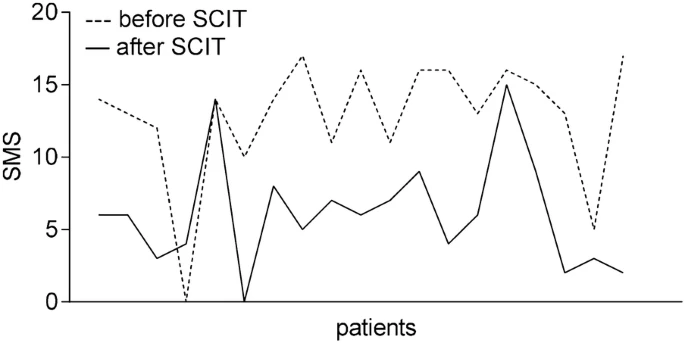- Research
- Open Access
Allergy, Asthma & Clinical Immunology 16, Article number: 18 (2020)
Abstract
Background
Biomarkers of clinical efficacy for subcutaneous immunotherapy (SCIT) on allergic rhinitis (AR) have not been identified yet. This study aims to assess the clinical relevance of serum inhibitory activity for IgE by the method of enzyme-linked immunosorbent facilitated antigen binding (ELIFAB) during SCIT for Artemisia-sensitized AR patients.
Methods
19 AR patients were studied who had undergone Artemisia-specific SCIT for more than 8 months (19.68 months on average, ranging from 9 to 33 months). Peripheral bloods were collected before and after treatment. The serum inhibitory activity for IgE was tested by ELIFAB and the level of Artemisia-specific IgG4 (Artemisia-sIgG4) was determined by ELISA. Clinical improvement was evaluated based on the symptom scores and rescue medication use (SMS). The 2-tailed Wilcoxon signed-rank test and the Spearman rank test (two-tailed) were used to analyze data by using SPSS 20.0, with P values of less than 0.05 considered as significant.
Results
 |
| Changes of SMS during SCIT |
The SMS decreased significantly after SCIT (before: 12.79 ± 4.250, after: 6.11 ± 3.828, P = 0.000 < 0.01), the treatment was remarkably effective for 6 patients, effective for 10 and ineffective for 3, along with a total effective rate 84.21%. The serum inhibitory activity for IgE increased significantly after SCIT (P < 0.05) and was correlated with the levels of Artemisia-sIgG4 (r = − 0.501, P = 0.002 < 0.01). The levels of Artemisia-sIgG4 elevated dramatically after treatment (P < 0.01) and were related with the duration of treatment (r = 0.558, P = 0.000 < 0.01). But there was no relationship between clinical improvements and the serum inhibitory activity for IgE.
Conclusions
The serum inhibitory activity for IgE increased significantly after SCIT, however, there was no correlation between it and clinical improvements by statistics analysis. So whether the serum inhibitory activity for IgE can act as biomarker of efficacy for SCIT or not needs to be studied further.
No comments:
Post a Comment